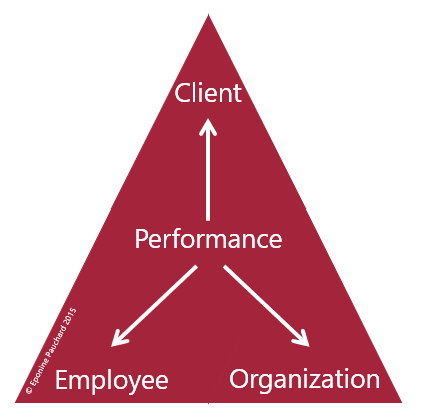When we talk about performance, several things come to mind.
The majority think about indicators, numbers, data. It is true that measurement is useful, but it comes in a second step, you must first understand your performance framework, in order to be able to define good indicators.

Some people think of the Q.C.D. trio (Quality, Costs, Deadlines). The latter is more limited and only applies to a product or service. I suggest you broaden your perspective and replace this trio with a much more powerful one. However, the principles would also apply to quality, cost and delay.
How to be successful? This is the question that every company asks itself, because it ensures success and sustainability. Here are three components that make up performance: the organization, the team and the client. These three axes apply as much to a product, a service, a project, a department as to an organization.
The three axes of the performance triangle
Each of the axes is used to define what the stakeholder gets out of the product, service or organization. What is the value proposition to the customer? What’s in it for the organization? Finally, what does your employee get?

Let’s take two examples to better understand. First a user support service, then a shoemaking company.
The easiest axis to complete is the customer axis. Indeed, the goal or mission of the organization is often customer-focused. In the first example, it is about supporting the client to use their computer or equipment to its full potential. It could also be to solve their punctual problems. In the second example, the goal is to offer the customer a quality shoe, at an advantageous cost and in a style that suits them. The Q.C.D. characteristics are included in the product offer.
What does the organization gain? Loyal and satisfied customers, profits and notoriety.
For the employee it is more difficult: the technical advisor may take pride in solving user problems, in explaining the use of features. The sales consultant may have free shoes, flexible working hours.
There are no favorable winds for those who do not know where they are going.
Seneca (4 B.C. – 65 A.D.) Roman stoic philosopher, playwright and statesman
A company must therefore know its objectives and ambitions in each of the three areas in order to make the right decisions and measure its performance.
A balanced triangle
Beyond the goals for the organization, the customer and the employee, it is important to know how to distribute the efforts. Choices must be made: the sum of the angles of a triangle cannot exceed 180°. If you have very strong organizational goals, for example to gain 10 points of market share, you won’t have the energy to work on the other two axes as hard. A triangle is quick to draw, so is yours isosceles (same weight for all three axes) or some other shape?

Three interrelated axes
In the end, each of the axes contributes to the other two. Thus, it is the corporate culture and senior management that define the balance to be given to the triangle. Performance is achieved when the three axes are well defined, respected and of a suitable weight, as in the two triangles on the left. On the other hand, the triangle on the right will not bring as much performance as the other two. Indeed, its center of gravity (performance) is more difficult to determine. The resulting fragile balance is not very sustainable.
Which axis to prioritize?
- Customer focus: a satisfied customer is loyal, consumes more from the brand and generates self-promotion through word-of-mouth. The organization sells more products, the employee isvalued (by satisfied customers and job sustainability). The risk is to be too customer-centric and to generate losses by offering too much to the customer. You could penalize the employee by asking too much of them for the customer.
- Organizational focus: stable, sustained finances, excellent control of expenses and investments support good quality products/services at good prices. This results in satisfied customers and satisfied employees. The risk is not to ensure the quality of the product/service (to save money for example), not to reward the employee at their fair value (low salary) or to proceed to layoffs and ask more from those who remain.
- Employee focus: happiness at work is a shared responsibility with employees that makes them more productive. The organization is therefore competitive and offers products/services similar or superior to the market. Customers know this and buy. The risk is to do too much for employees and for the empowerment model to go too far (case of Zappos in 2015, with 14% of employees quitting). This is the model followed by “liberated” companies.
Define your performance triangle
Have you already defined your performance? What is the corporate vision? How do you want to achieve this? What are your medium and long-term objectives in the three areas?
It is by answering these questions, and by drawing some triangles that your axes will be balanced around the center of gravity of performance!
